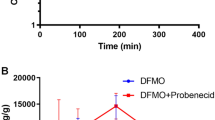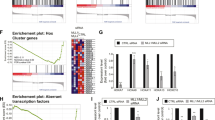Abstract
Methylnaltrexone (MNTX) was recently FDA approved to treat opiate induced constipation. It happens to also indirectly reduce Src activity. Src is a 54 kDa tyrosine kinase, crucial in signaling of, and link between, vascular endothelial growth factor (VEGF), and epidermal growth factor (EGF). Glioblastomas use both EGF and VEGF signaling to enhance growth and neo-angiogenesis. Stem cell sub-fractions of glioblastomas are enriched for high VEGF synthesizing cells so this is a particularly valuable adjunctive target during cytotoxic treatment with drugs like temozolomide. MNTX does not cross the blood–brain barrier (BBB). Methamphetamine (MA) temporarily opens the BBB and therefore may allow methylnaltrexone entry into glioblastoma tissue. MA is FDA approved, marketed to treat attention problems in children. MA–MNTX combination should be tested as glioblastoma treatment adjunct. Temozolomide CSF levels are 10–20% of blood levels. Thus MA may also allow greater brain tissue temozolomide levels yet with lower systemic exposure.

Similar content being viewed by others
References
Yuan CS (2007) Methylnaltrexone mechanisms of action and effects on opioid bowel dysfunction and other opioid adverse effects. Ann Pharmacother 41(6):984–993. doi:10.1345/aph.1K009
Singleton PA, Lingen MW, Fekete MJ, Garcia JG, Moss J (2006) Methylnaltrexone inhibits opiate and VEGF-induced angiogenesis: role of receptor transactivation. Microvasc Res 72(1–2):3–11. doi:10.1016/j.mvr.2006.04.004
Singleton PA, Garcia JG, Moss J (2008) Synergistic effects of methylnaltrexone with 5-fluorouracil and bevacizumab on inhibition of vascular endothelial growth factor-induced angiogenesis. Mol Cancer Ther 7(6):1669–1679. doi:10.1158/1535-7163.MCT-07-2217
Wong ET, Brem S (2008) Antiangiogenesis treatment for glioblastoma multiforme: challenges and opportunities. J Natl Compr Canc Netw 6(5):515–522
Plate KH, Breier G, Weich HA, Mennel HD, Risau W (1994) Vascular endothelial growth factor and glioma angiogenesis: coordinate induction of VEGF receptors, distribution of VEGF protein and possible in vivo regulatory mechanisms. Int J Cancer 59(4):520–529. doi:10.1002/ijc.2910590415
Charalambous C, Chen TC, Hofman FM (2006) Characteristics of tumor-associated endothelial cells derived from glioblastoma multiforme. Neurosurg Focus 20(4):E22. doi:10.3171/foc.2006.20.4.e22
Hong X, Jiang F, Kalkanis SN, Zhang ZG, Zhang XP, DeCarvalho AC, Katakowski M, Bobbitt K, Mikkelsen T, Chopp M (2006) SDF-1 and CXCR4 are up-regulated by VEGF and contribute to glioma cell invasion. Cancer Lett 236(1):39–45. doi:10.1016/j.canlet.2005.05.011
Kast RE (2007) Using blood brain barrier disruption by methamphetamine for drug delivery. J Neurooncol 85(1):109–110. doi:10.1007/s11060-007-9389-0
Stevenson CB, Ehtesham M, McMillan KM, Valadez JG, Edgeworth ML, Price RR, Abel TW, Mapara KY, Thompson RC (2008) CXCR4 expression is elevated in glioblastoma multiforme and correlates with an increase in intensity and extent of peritumoral T2-weighted magnetic resonance imaging signal abnormalities. Neurosurgery 63(3):560–569. doi:10.1227/01.NEU.0000324896.26088.EF
Zagzag D, Esencay M, Mendez O, Yee H, Smirnova I, Huang Y, Chiriboga L, Lukyanov E, Liu M, Newcomb EW (2008) Hypoxia- and vascular endothelial growth factor-induced stromal cell-derived factor-1alpha/CXCR4 expression in glioblastomas: one plausible explanation of Scherer’s structures. Am J Pathol 173(2):545–560. doi:10.2353/ajpath.2008.071197
Ostermann S, Csajka C, Buclin T, Leyvraz S, Lejeune F, Decosterd LA, Stupp R (2004) Plasma and cerebrospinal fluid population pharmacokinetics of temozolomide in malignant glioma patients. Clin Cancer Res 10(11):3728–3736. doi:10.1158/1078-0432.CCR-03-0807
Prados MD, Lamborn K, Yung WK, Jaeckle K, Robins HI, Mehta M, Fine HA, Wen PY, Cloughesy T, Chang S, Nicholas MK, Schiff D, Greenberg H, Junck L, Fink K, Hess K, Kuhn J, North American Brain Tumor Consortium (2006) A phase 2 trial of irinotecan (CPT-11) in patients with recurrent malignant glioma: a North American brain tumor consortium study. Neuro Oncol 8(2):189–193. doi:10.1215/15228517-2005-010
Puduvalli VK, Giglio P, Groves MD, Hess KR, Gilbert MR, Mahankali S, Jackson EF, Levin VA, Conrad CA, Hsu SH, Colman H, de Groot JF, Ritterhouse MG, Ictech SE, Yung WK (2008) Phase II trial of irinotecan and thalidomide in adults with recurrent glioblastoma multiforme. Neuro Oncol 10(2):216–222. doi:10.1215/15228517-2007-060
Blaney SM, Takimoto C, Murry DJ, Kuttesch N, McCully C, Cole DE, Godwin K, Balis FM (1998) Plasma and cerebrospinal fluid pharmacokinetics of 9-aminocamptothecin (9-AC), irinotecan (CPT-11), and SN-38 in nonhuman primates. Cancer Chemother Pharmacol 41(6):464–468. doi:10.1007/s002800050768
Reardon DA, Fink KL, Mikkelsen T, Cloughesy TF, O’Neill A, Plotkin S, Glantz M, Ravin P, Raizer JJ, Rich KM, Schiff D, Shapiro WR, Burdette-Radoux S, Dropcho EJ, Wittemer SM, Nippgen J, Picard M, Nabors LB (2008) Randomized phase II study of cilengitide, an integrin-targeting arginine-glycine-aspartic acid peptide, in recurrent glioblastoma multiforme. J Clin Oncol 26(34):5610–5617. doi:10.1200/JCO.2008.16.7510
Benati D, Baldari CT (2008) SRC family kinases as potential therapeutic targets for malignancies and immunological disorders. Curr Med Chem 15(12):1154–1165. doi:10.2174/092986708784310404
Brunton VG, Frame MC (2008) Src and focal adhesion kinase as therapeutic targets in cancer. Curr Opin Pharmacol 8(4):427–432. doi:10.1016/j.coph.2008.06.012
Flynn JR, Wang L, Gillespie DL, Stoddard GJ, Reid JK, Owens J, Ellsworth GB, Salzman KL, Kinney AY, Jensen RL (2008) Hypoxia-regulated protein expression, patient characteristics, and preoperative imaging as predictors of survival in adults with glioblastoma multiforme. Cancer 113(5):1032–1042. doi:10.1002/cncr.23678
Yao XH, Ping YF, Chen JH, Xu CP, Chen DL, Zhang R, Wang JM, Bian XW (2008) Glioblastoma stem cells produce vascular endothelial growth factor by activation of a G-protein coupled formylpeptide receptor FPR. J Pathol 215(4):369–376. doi:10.1002/path.2356
Ananthnarayan S, Bahng J, Roring J, Nghiemphu P, Lai A, Cloughesy T, Pope WB (2008) Time course of imaging changes of GBM during extended bevacizumab treatment. J Neurooncol 88(3):339–347. doi:10.1007/s11060-008-9573-x
Norden AD, Young GS, Setayesh K, Muzikansky A, Klufas R, Ross GL, Ciampa AS, Ebbeling LG, Levy B, Drappatz J, Kesari S, Wen PY (2008) Bevacizumab for recurrent malignant gliomas: efficacy, toxicity, and patterns of recurrence. Neurology 70(10):779–787. doi:10.1212/01.wnl.0000304121.57857.38
Bergers G, Hanahan D (2008) Modes of resistance to anti-angiogenic therapy. Nat Rev Cancer 8(8):592–603. doi:10.1038/nrc2442
Zuniga RM, Torcuator R, Jain R, Anderson J, Doyle T, Ellika S, Schultz L, Mikkelsen T (2009) Efficacy, safety and patterns of response and recurrence in patients with recurrent high-grade gliomas treated with bevacizumab plus irinotecan. J Neurooncol 91(3):329–336. doi:10.1007/s11060-008-9718-y
Maharaj AS, Saint-Geniez M, Maldonado AE, D’Amore PA (2006) Vascular endothelial growth factor localization in the adult. Am J Pathol 168(2):639–648. doi:10.2353/ajpath.2006.050834
Chen S, Kasama Y, Lee JS, Jim B, Marin M, Ziyadeh FN (2004) Podocyte-derived vascular endothelial growth factor mediates the stimulation of alpha3(IV) collagen production by transforming growth factor-beta1 in mouse podocytes. Diabetes 53(11):2939–2949. doi:10.2337/diabetes.53.11.2939
Knizetova P, Ehrmann J, Hlobilkova A, Vancova I, Kalita O, Kolar Z, Bartek J (2008) Autocrine regulation of glioblastoma cell cycle progression, viability and radioresistance through the VEGF-VEGFR2 (KDR) interplay. Cell Cycle 7(16):2553–2561
Huang J, Chen K, Gong W, Zhou Y, Le Y, Bian X, Wang JM (2008) Receptor “hijacking” by malignant glioma cells: a tactic for tumor progression. Cancer Lett 267(2):254–261. doi:10.1016/j.canlet.2008.03.014
Huang J, Hu J, Bian X, Chen K, Gong W, Dunlop NM, Howard OM, Wang JM (2007) Transactivation of the epidermal growth factor receptor by formylpeptide receptor exacerbates the malignant behavior of human glioblastoma cells. Cancer Res 67(12):5906–5913. doi:10.1158/0008-5472.CAN-07-0691
Goldman CK, Kim J, Wong WL, King V, Brock T, Gillespie GY (1993) Epidermal growth factor stimulates vascular endothelial growth factor production by human malignant glioma cells: a model of glioblastoma multiforme pathophysiology. Mol Biol Cell 4(1):121–133
Fisher T, Galanti G, Lavie G, Jacob-Hirsch J, Kventsel I, Zeligson S, Winkler R, Simon AJ, Amariglio N, Rechavi G, Toren A (2007) Mechanisms operative in the antitumor activity of temozolomide in glioblastoma multiforme. Cancer J 13(5):335–344. doi:10.1097/PPO.0b013e318157053f
Steiner HH, Karcher S, Mueller MM, Nalbantis E, Kunze S, Herold-Mende C (2004) Autocrine pathways of the vascular endothelial growth factor (VEGF) in glioblastoma multiforme: clinical relevance of radiation-induced increase of VEGF levels. J Neurooncol 66(1–2):129–138. doi:10.1023/B:NEON.0000013495.08168.8f
Lund EL, Høg A, Olsen MW, Hansen LT, Engelholm SA, Kristjansen PE (2004) Differential regulation of VEGF, HIF1-alpha and angiopoietin-1, -2 and -4 by hypoxia and ionizing radiation in human glioblastoma. Int J Cancer 108(6):833–838. doi:10.1002/ijc.11662
Hovinga KE, Stalpers LJ, van Bree C, Donker M, Verhoeff JJ, Rodermond HM, Bosch DA, van Furth WR (2005) Radiation-enhanced vascular endothelial growth factor (VEGF) secretion in glioblastoma multiforme cell lines—a clue to radioresistance? J Neurooncol 74(2):99–103. doi:10.1007/s11060-004-4204-7
Du J, Bernasconi P, Clauser KR, Mani DR, Finn SP, Beroukhim R, Burns M, Julian B, Peng XP, Hieronymus H, Maglathlin RL, Lewis TA, Liau LM, Nghiemphu P, Mellinghoff IK, Louis DN, Loda M, Carr SA, Kung AL, Golub TR (2009) Bead-based profiling of tyrosine kinase phosphorylation identifies Src as a potential target for glioblastoma therapy. Nat Biotechnol 27(1):77–83. doi:10.1038/nbt.1513
Author information
Authors and Affiliations
Corresponding author
Rights and permissions
About this article
Cite this article
Kast, R.E. Use of FDA approved methamphetamine to allow adjunctive use of methylnaltrexone to mediate core anti-growth factor signaling effects in glioblastoma. J Neurooncol 94, 163–167 (2009). https://doi.org/10.1007/s11060-009-9863-y
Received:
Accepted:
Published:
Issue Date:
DOI: https://doi.org/10.1007/s11060-009-9863-y




